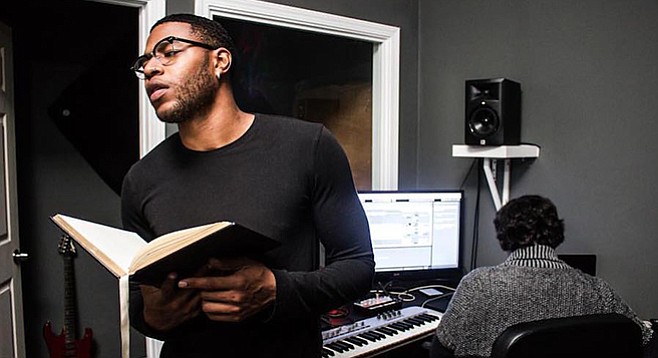 Facebook
Facebook
 X
X
 Instagram
Instagram
 TikTok
TikTok
 Youtube
Youtube

The Holyfield, which started providing free studio time to local residents at the now-defunct Thchrch (2185 Logan Avenue), wants to be in Barrio Logan — though it doesn’t always make money.
“We charge when we can,” says Holyfield owner Ramel Wallace. The Holyfield has produced albums by Wallace, Dayfade, students from Platt College, and others. Wallace says the studio is open to all.
“I feel a deep connection to the people here,” the fourth-generation Barrio Logan resident says. “Most people tell me they have the same story. ‘I grew up on this street in Barrio Logan and my great-grandmother on this one,’ they say. That is a reflection of this area, and California. These stories are all connected. Why minorities are down here in Barrio Logan dates back to ‘redlining,’ which only allowed certain people to live in certain places.”
The Grossmont HS grad appears in a YouTube video titled, “Last Black Man in Barrio Logan.” It “is the story of a lot of people,” an attempt by Wallace to learn his lineage here.
He says people, especially in low-income communities, need space. “Places to meet instead of the internet,” he explains. “The purpose is to capture the culture as it’s happening or else they are going to ‘CTRL+ALT+Delete’ it....
“How might economic expansion affect the Southeast? How might that tear apart communities?” he wonders. “Either way, we will make music, go to schools, teach kids how to make music, how to live....
“We want the kids to go into the studio and turn themselves into icons,” he says. “Television, schoolbooks, none of this stuff teaches us about ourselves. The values we had have been deleted. We have to go through the computer, through [browser] tabs, to refine ourselves now.”


The Holyfield, which started providing free studio time to local residents at the now-defunct Thchrch (2185 Logan Avenue), wants to be in Barrio Logan — though it doesn’t always make money.
“We charge when we can,” says Holyfield owner Ramel Wallace. The Holyfield has produced albums by Wallace, Dayfade, students from Platt College, and others. Wallace says the studio is open to all.
“I feel a deep connection to the people here,” the fourth-generation Barrio Logan resident says. “Most people tell me they have the same story. ‘I grew up on this street in Barrio Logan and my great-grandmother on this one,’ they say. That is a reflection of this area, and California. These stories are all connected. Why minorities are down here in Barrio Logan dates back to ‘redlining,’ which only allowed certain people to live in certain places.”
The Grossmont HS grad appears in a YouTube video titled, “Last Black Man in Barrio Logan.” It “is the story of a lot of people,” an attempt by Wallace to learn his lineage here.
He says people, especially in low-income communities, need space. “Places to meet instead of the internet,” he explains. “The purpose is to capture the culture as it’s happening or else they are going to ‘CTRL+ALT+Delete’ it....
“How might economic expansion affect the Southeast? How might that tear apart communities?” he wonders. “Either way, we will make music, go to schools, teach kids how to make music, how to live....
“We want the kids to go into the studio and turn themselves into icons,” he says. “Television, schoolbooks, none of this stuff teaches us about ourselves. The values we had have been deleted. We have to go through the computer, through [browser] tabs, to refine ourselves now.”
Comments